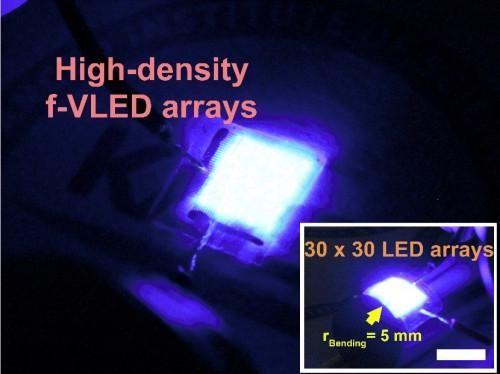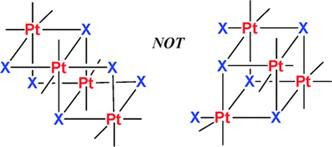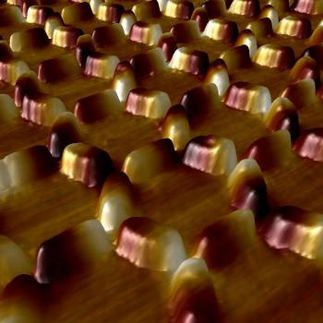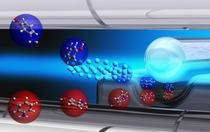Thin films of nickel and iron oxides yield efficient solar water-splitting catalyst
Basic University of Oregon research shows promise in efforts to get hydrogen fuel from sunlight and water
University of Oregon chemists say that ultra-thin films of nickel and iron oxides made through a solution synthesis process are promising catalysts to combine with semiconductors to make devices that capture sunlight and convert water into hydrogen and oxygen gases.
Researchers in the Solar Materials and Electrochemistry Laboratory of Shannon Boettcher, professor of chemistry, studied the catalyst material and also developed a computer model for applying catalyst thin films in solar water-splitting devices as a tool to predict the effectiveness of a wide range of catalyst materials for solar-hydrogen production.
The project has resulted in two recent papers.
The first, detailed last September in the Journal of the American Chemical Society, showed that films of a nickel-iron mixed oxide with an atomic structure similar to naturally occurring minerals show the highest catalytic activity for forming oxygen from water, based on a side-by-side comparison of eight oxide-based materials targeted in various research efforts. The second paper, just published in the Journal of Physical Chemistry Letters, details the performance of the catalyst thin films when combined with semiconductor light absorbers, showing that the nickel-iron oxide catalyst was most effective with a film just 0.4 nanometers thick.
Boettcher's lab, located in the UO's Materials Science Institute, studies fundamental materials chemistry and physical concepts related to the conversion of solar photons (sunlight) into electrons and holes in semiconductors that can then be used to drive chemical processes such as splitting protons off water to make hydrogen and oxygen gases. Multiple labs across the country are seeking effective and economical ways of taking sunlight and directly producing hydrogen gas as an alternative sustainable fuel to replace fossil fuels.
"When you want to pull the protons off a water molecule to make hydrogen gas for fuel, you also have to take the leftover oxygen atoms and make oxygen gas out of them," Boettcher said. "It turns out that the slowest, hardest, most-energy-consuming step in the water-splitting process is actually the oxygen-making step. We've been studying catalysts for making oxygen. Specifically, we're seeking catalysts that reduce the amount of energy it takes in this step and that don't use expensive precious metals."
The iron-nickel oxides, he said, have higher catalytic activity than the precious-metal-based catalytic materials that have been thought to be the best for the job.
"What we found is that when we take nickel oxide films that start out as a crystalline material with the rock-salt structure like table salt, they absorb iron impurities and spontaneously convert into materials with a layered structure during the catalysis process," Boettcher said.
Lena Trotochaud, a doctoral student and lead author on both papers, studied this process and how the films can be combined with semiconductors. "The semiconductors absorb the light, generating electron-hole pairs which move onto the catalyst material and proceed to drive the water-splitting reaction, creating fuel," Boettcher said.
The computer modeling was used to understand how the amount of sunlight that the catalyst blocks from reaching the semiconductor can be minimized while simultaneously speeding up the reaction with water to form oxygen gas. This basic discovery remains a lab accomplishment for now, but it could advance to testing in a prototype device, Boettcher added.
"We're now looking at the fundamental reasons why these materials are good," Trotochaud said. "We are trying to understand how the catalyst works by focusing on the chemistry that is happening, and then also recognizing how that fits into a real system. Our research is fundamentally guiding how you would take these catalysts and incorporate them into something that is useful for everyone in society."
One such place the material could land in a prototype for testing is at the U.S. Department of Energy's Joint Center for Artificial Photosynthesis, an Energy Innovation Hub. The DOE supported Boettcher's research done in the second study through a Basic Sciences Energy grant (DE-FG02-12ER16323).
"This research holds great potential for the development of more efficient, more sustainable solar-fuel generation systems and other kinds of transformative energy technology," said Kimberly Andrews Espy, vice president for research and innovation and dean of the graduate school. "By seeking to advance carbon-neutral energy technology, Dr. Boettcher and his team are helping to establish Oregon as an intellectual and economic leader in fostering a sustainable future for our planet and its people."
Most read news
Organizations
Other news from the department science

Get the chemical industry in your inbox
By submitting this form you agree that LUMITOS AG will send you the newsletter(s) selected above by email. Your data will not be passed on to third parties. Your data will be stored and processed in accordance with our data protection regulations. LUMITOS may contact you by email for the purpose of advertising or market and opinion surveys. You can revoke your consent at any time without giving reasons to LUMITOS AG, Ernst-Augustin-Str. 2, 12489 Berlin, Germany or by e-mail at revoke@lumitos.com with effect for the future. In addition, each email contains a link to unsubscribe from the corresponding newsletter.
Most read news
More news from our other portals
Last viewed contents
ABBOTT'S BIAXIN® (CLARITHROMYCIN) ACTIVE AGAINST ANTHRAX IN VITRO

Flexible blue vertical micro LEDs developed
Henry_George_Smith
Haber's_Law
How copper makes organic light-emitting diodes more efficient - Researchers measure intersystem crossing directly in a thermally activated delayed fluorescence copper complex
Category:Human_MHC_haplogroups
ELSI scientists discover new chemistry that may help explain the origins of cellular life - Chemists find simplest organic molecules can self-assemble to give cell-like structures under early Earth conditions
Henkel heading for further profitable growth with adhesives
Category:Proteins_by_species
Univar invests in upgraded facilities in Italy to service its agreement with SAFECHEM in Southern Europe



























































